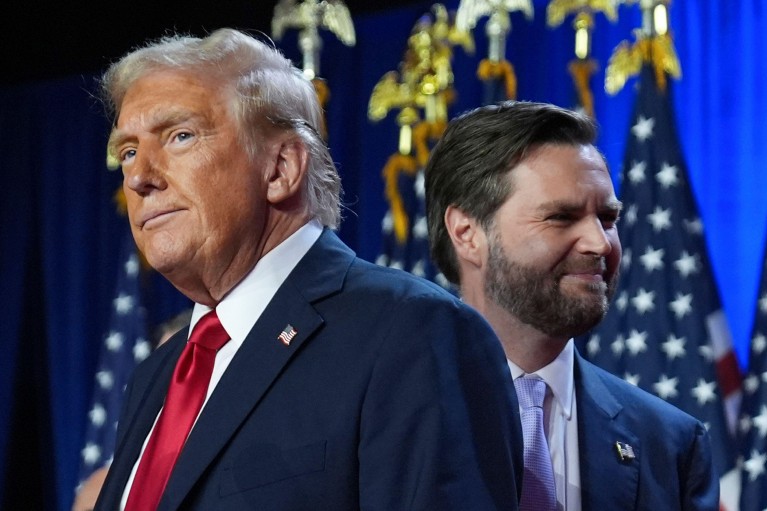Hello Nature readers, would you like to get this Briefing in your inbox free every day? Sign up here.

Soon-to-be US president Donald Trump (left) and his vice-president, J.D. Vance, at an election night watch party.Credit: Evan Vucci/AP Photo/Alamy
‘We need to be ready for a new world’
Owing to Donald Trump’s anti-science rhetoric and actions in his first term as US president, many scientists say they are bracing for negative impacts on science now that he has been elected for a second term. Their concerns include climate change, public health and the state of US democracy. “In my long life of 82 years … there has hardly been a day when I felt more sad,” says Nobel Prize-winning chemist Fraser Stoddart, who left the United States last year and now works in Hong Kong. “I’ve witnessed something that I feel is extremely bad, not just for the United States, but for all of us in the world.”
Nature | 4 min read
Nature’s take on the US election result
“We hope the incoming administration will govern in the best interests of the United States,” says a Nature editorial on Donald Trump’s victory. “That means holding onto the best of what the previous administration did, and not returning to some of the policies of the first Trump presidency.” The editorial suggests respecting the consensus of research evidence to inform regulatory decisions in areas such as artificial intelligence, maintaining a focus on climate change and continuing to support international bodies including the World Health Organization. “The research community must engage with the new administration with courage, tenacity, strength and unity of purpose,” says the editorial. “Scientists in the United States must know they are not alone.”
Nature | 4 min read
News
AI tools could help spot AI fakes
An arms race is emerging as integrity specialists, publishers and technology companies rush to develop tools that can assist in rapidly detecting AI-generated images in scientific papers. The makers of tools such as Imagetwin and Proofig, which use AI to detect integrity issues in scientific figures, are training their algorithms on databases of AI-generated images to make them better at spotting dupes. “Fraudsters shouldn’t sleep well at night,” says Kevin Patrick, a scientific-image sleuth known as Cheshire on social media. “They could fool today’s process, but I don’t think they’ll be able to fool the process forever.”
Nature | 8 min read

Credit: Proofig (generated images)
Cat brains age like human ones do
As cats get older, their brains show signs of atrophy and cognitive decline that resemble the deterioration seen in humans more closely than do brain changes in mice. Researchers have so far collected health records and blood test results from thousands of felines and taken brain scans of more than 50 to map events along the nonlinear relationship between cat and human ages. Cats could prove a valuable model for studying ageing in human brains because they live longer than mice and share an environment with their owners, and have not been as highly inbred for specific traits as dogs.
Nature | 5 min read
Heart attacks trigger deep healing sleep
Immune cells rush to the brain after a heart attack, promoting a deep sleep that eases inflammation in the heart. Researchers found that mice that had suffered heart attacks spent more time in slow-wave sleep, a stage of deep sleep associated with healing. They traced the extra slumber to immune cells called monocytes, which flooded the mice’s brains and produced a protein that promotes sleep and regulates inflammation. In humans who had experienced a blockage of blood to the heart, the team found that those who slept poorly in the weeks following such an episode had a higher risk of severe heart problems over the next two years than did those who were good sleepers.
Nature | 4 min read
Reference: Nature paper
Features & opinion
The protein problems AI can’t solve (yet)
Artificial intelligence (AI) tools that can predict protein structures from an amino acid sequence, or generate new ones, have redefined the protein-engineering landscape (and won their developers this year’s Nobel Prize in Chemistry). But the tools are still far from perfect. Hurdles such as working out the connection between enzyme structure and function, or predicting conformational changes, have yet to be cleared. Nature spoke to specialists about the biggest challenges facing protein design and what it will take to overcome them.
Nature | 11 min read
Chemistry isn’t out of reach for amateurs
When chemist Claire Murray needed to prepare and analyse a mountain of calcium carbonate samples, secondary schools stepped in to help — and got to take part in a real research project. The technicalities of lab work and safety protocols can seem prohibitive to the inclusion of citizen scientists in chemistry, writes Murray, but barriers can be overcome if the project is planned appropriately and has a robust protocol. “The world is full of budding scientists ready to make and break chemical bonds,” says Murray. “Their curiosity can lead you down (reaction) pathways you never expected.”
Nature | 5 min read
